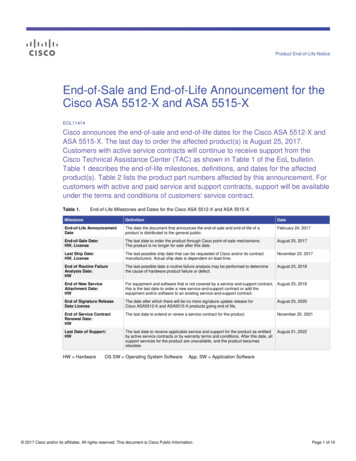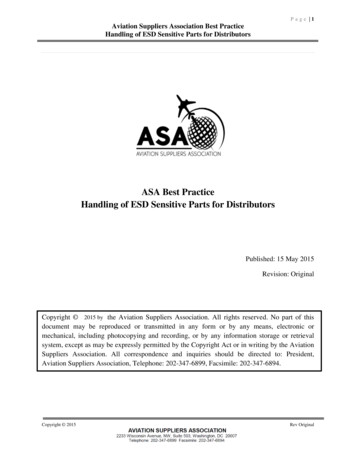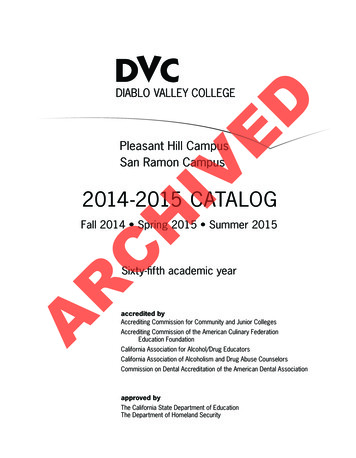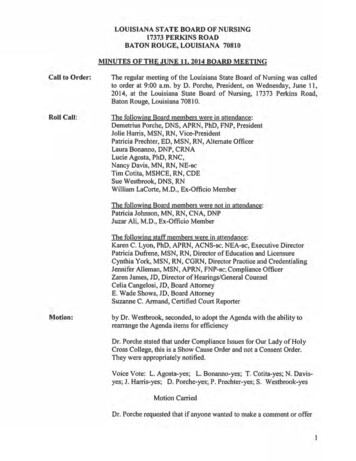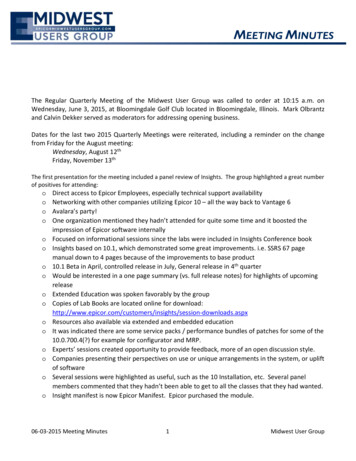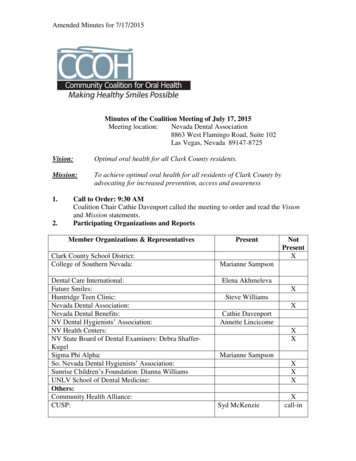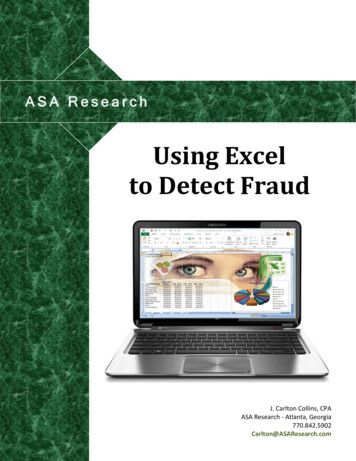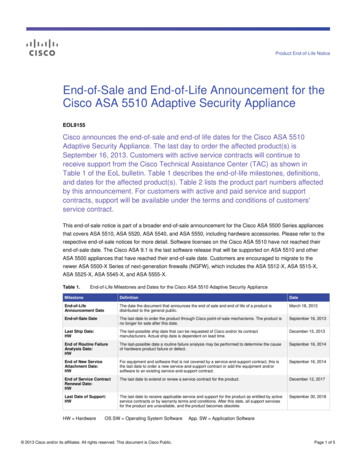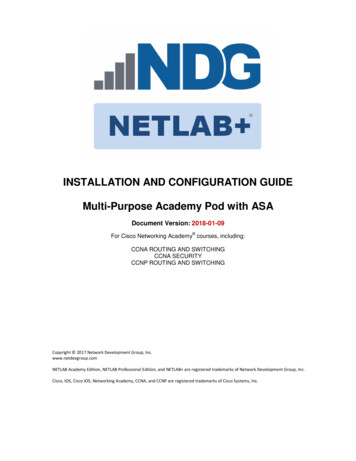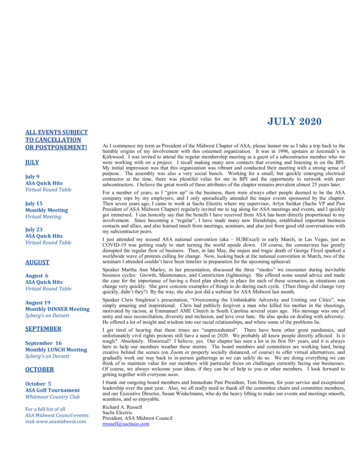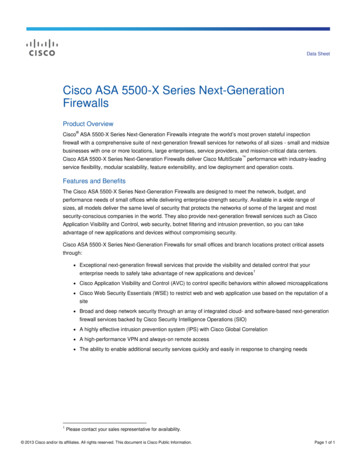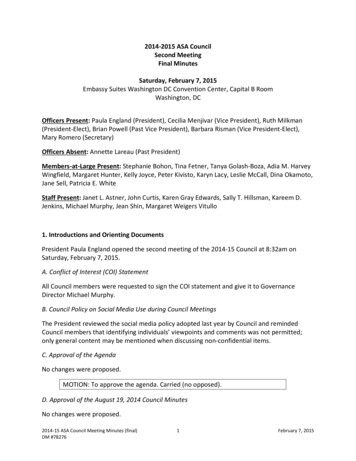
Transcription
2014‐2015 ASA CouncilSecond MeetingFinal MinutesSaturday, February 7, 2015Embassy Suites Washington DC Convention Center, Capital B RoomWashington, DCOfficers Present: Paula England (President), Cecilia Menjivar (Vice President), Ruth Milkman(President‐Elect), Brian Powell (Past Vice President), Barbara Risman (Vice President‐Elect),Mary Romero (Secretary)Officers Absent: Annette Lareau (Past President)Members‐at‐Large Present: Stephanie Bohon, Tina Fetner, Tanya Golash‐Boza, Adia M. HarveyWingfield, Margaret Hunter, Kelly Joyce, Peter Kivisto, Karyn Lacy, Leslie McCall, Dina Okamoto,Jane Sell, Patricia E. WhiteStaff Present: Janet L. Astner, John Curtis, Karen Gray Edwards, Sally T. Hillsman, Kareem D.Jenkins, Michael Murphy, Jean Shin, Margaret Weigers Vitullo1. Introductions and Orienting DocumentsPresident Paula England opened the second meeting of the 2014‐15 Council at 8:32am onSaturday, February 7, 2015.A. Conflict of Interest (COI) StatementAll Council members were requested to sign the COI statement and give it to GovernanceDirector Michael Murphy.B. Council Policy on Social Media Use during Council MeetingsThe President reviewed the social media policy adopted last year by Council and remindedCouncil members that identifying individuals’ viewpoints and comments was not permitted;only general content may be mentioned when discussing non‐confidential items.C. Approval of the AgendaNo changes were proposed.MOTION: To approve the agenda. Carried (no opposed).D. Approval of the August 19, 2014 Council MinutesNo changes were proposed.2014‐15 ASA Council Meeting Minutes (final)DM #782761February 7, 2015
MOTION: To approve the minutes for the Council meeting on August 19,2014. Carried (no opposed).E. Approval of the August 20, 2014 Council MinutesNo changes were proposed.MOTION: To approve the minutes for the Council meeting on August 20,2014. Carried (no opposed).2. Financial Reports and BudgetsThe Secretary reordered agenda items so that Council could discuss the page increase forContemporary Sociology before reviewing the proposed 2015 budget. Before proceeding,Romero advised Council members to read the material covering frequently asked questionsabout the ASA budget.A. One Year Page Increase for Contemporary SociologyThe Secretary reported that the incoming editor of Contemporary Sociology, Michael Sauder,asked the Committee on Publications for an additional 50 pages for the 2015 volume year tohelp alleviate the backlog from the previous editor. The committee approved the request,which was then considered by the Committee on the Executive Office and Budget (EOB). TheEOB recommended that Council approve the page increase for 2015.MOTION: That Council approve a 50‐page increase for ContemporarySociology in 2015 at a cost of 90 per page ( 4,500) to alleviate the excessbacklog from the previous editor. Carried (no opposed).B. Current (2014) Financials and Proposed 2015 Operating BudgetThe Secretary reported that projections for 2014 were that revenues would be below budget by 118,000 and expenses would be above budget by 55,000, yielding a year‐end deficitprojection of ( 144,000). Membership continues to decline, as do most revenue categories tiedto membership levels. Rental income dropped because the tenant space was empty for sixmonths. Annual Meeting expenses were higher, and some personnel costs rose due toemployee transitions.The proposed 2015 budget anticipated higher revenues from the SAGE contract as well as anincrease in Annual Meeting revenues. On the expense side, Annual Meeting expenses wereraised to support an expanded program and the ongoing higher costs of audio visual support.Proposed revenues for 2015 were 6,756,742 and expenses were 6,725,870, resulting in a netbudget that is positive by 30,872.MOTION: To approve 2015 budget proposal. Carried (no opposed).2014‐15 ASA Council Meeting Minutes (final)DM #782762February 7, 2015
C. Proposed 2015 Spivack BudgetThe proposed 2015 budget for the Spivack Program was similar to its 2014 budget. TheSecretary presented EOB’s recommendation to approve the 2015 Spivack budget and notedthat the program of the 2015 Annual Meeting will include a session that highlights the workdone by some of the Community Action Research Initiative (CARI) grant recipients.MOTION: To approve the 2015 Spivack Budget. Carried (no opposed).D. MFP Budget 2015‐2016The MFP budget for 2015‐2016 proposed funding for 4 stipends and two non‐stipendiaryawards and requested that Council consider allocating support from the Spivack Fund toprovide two additional stipends, as was done for 2014‐2015. MFP Director Jean Shin reportedthat 108 applications were submitted for fellowships in the current round; the MFP AdvisoryPanel will make funding decisions in March. All MFP awards are given for one year; multipleyear awards ended in 2010 when the NIMH training grant support terminated.MOTION: To approve a 2015‐2016 MFP budget of 84,000 for four MFPFellowship awards (at 20,000 each) and up to two non‐stipendiary MFPawards (at 2,000 each) from General Fund #53, and authorize 40,000 fromthe Spivack Fund for two additional stipends (at 20,000 each), bringing thetotal budget to 124,000 to support 6 MFP Fellows. Carried (no opposed).E. Update on the Refinancing of the ASA HeadquartersASA successfully completed its headquarters refinancing on December 1, 2014. Thesearrangements are in place for the next 10 years. Finance Director Les Briggs noted that theterms of financing included a provision that ASA must meet a minimum Debt Service Coverage(DSC) ratio of 1.20. The DSC ratio measure the Association’s ability to pay its principal andinterest on the loan.The financial provisions also contain a Liquidity Covenant which requires the Association’sunrestricted cash and investments not to fall below 75 percent of the loan amount. Briggsindicated there should be no difficulties meeting both of these loan requirements, as long asthe Association keeps the operating budget stable and continues its long term investingapproach.3. ASA Investments and ReservesA. General Financial Picture of ASA InvestmentsBriggs reported that net gains for the ASA investments through December 31, 2014 were 344,571 which put the account at an approximate 4.5% total gain for the twelve monthperiod.2014‐15 ASA Council Meeting Minutes (final)DM #782763February 7, 2015
In early January, the Investment Subcommittee met and reviewed the long term investmentsand also discussed the balance of the short term investments. Having agreed that the long terminvestments have performed well and that it was prudent to restore the short terminvestments back to their recommended 500,000 level, the EOB Investment Subcommitteerecommended (and Secretary Romero authorized) a 200,000 transfer from the General Fundto the short term investments which took place on January 9, 2015.Briggs concluded the report by noting that, if Council approved any additional large capitalprojects, it might necessitate withdrawing additional funds from the long term investments.B. Bernhardt Year‐End Investment ReportThe report from Bernhard Wealth Management, ASA’s investment advisor, was summarized,with specific notes about how well the portfolio is doing against industry benchmarks. Thevalue of ASA’s portfolio at the end of the year was 7,703,000. The EOB Investment Committeeintends to continue ASA’s investment strategy which uses an allocation of 65 percent stocksand 35 percent bonds for the portfolio.C. ReservesASA defines “reserves” as the unrestricted long‐term investments of the Association, alsoreferred to as the “General Fund Investment Account.” As mentioned earlier, a 200,000transfer of funds to the short term investment holdings at Merrill Lynch was authorized by theSecretary in order to replenish them to their typical 500,000 level. After that transfer, thereserve amount came to 5,648,868, or 86.8% of the 2014 operating budget. It was noted thatthe increase in total expenses in the proposed 2015 operating budget will reduce thispercentage as would a pull‐back in the market.4. Audit CommitteeThere was no report.5. PublicationsA. Subscriptions ReportMember subscriptions for all nine journals decreased at a rate greater than the membershipdecrease from 2012 subscriptions as anticipated. Additional individual member subscriptionshave also declined because most members can get access to journal subscriptions via theirinstitutions. The Secretary also noted that, beginning with the 2015 membership year, allmembers receive online access to all journals, so continued decline is anticipated and there isno particular cause for concern.2014‐15 ASA Council Meeting Minutes (final)DM #782764February 7, 2015
Although traditional institutional subscriptions to individual journals continue to declines slowlySAGE has significantly increased the exposure of the nine ASA journals it publishes throughconsortia arrangements and free access to libraries in developing nations. To achieve this wayof expanding journal subscriptions was one of ASA’s reasons for moving from self‐publishing toSAGE.B. Actions from Committee on Publications Meeting(1). Selection of EditorsCouncil went into Executive Session to discuss the selection of new editors for the AmericanSociological Review, Sociological Methodology, and Sociological Theory, and to receive abriefing about the editorship of the section journal City & Community. Council members withpotential conflicts of interest excused themselves from the discussion and left the meetingroom.(2). Extension of Editorial TermsCouncil had previously requested that any pro forma extensions on editors’ terms that involveda change in the editorial structure be brought to Council. Two editorships are at the point ofconsidering extensions, but neither involves any structural change. As an informational reportonly, it was noted that extensions were offered to the editors of the Journal of Health andSocial Behavior and Sociology of Education. Responses are expected by May.(3). Anonymous Vision Statements by Editor CandidatesIn December 2011, the Committee on Publications voted to begin posting anonymous visionstatements from ASA editor candidates for member input. The concept was intended toincrease transparency in the editor selection process, and to provide ASA members with anopportunity to provide input to the Committee on editor candidates’ vision and plans for thejournal without the identity of the candidates being public. Council approved this plan by theCommittee on a three‐year trial basis.The Secretary reported that at the end of the three‐year trial period the conclusion by thePublications Committee was that effort to get member responses on vision statements was notuseful. For two of the three years of the experiment, the practice caused particularly delicatesituations when there were late editor applications and/or too few applications. Moreimportant, actual member input in response to the posted vision statements was extremely lowdespite ASA advertising the availability for sociologists to do so. Furthermore, when input wasreceived, it was not particularly meaningful or useful in the Publication Committee’sdeliberations.Because the three‐year trial created significant difficulty in the editor selection process withvirtually no net gain, the Committee voted unanimously at its December 2014 meeting not torecommend its continuation to Council.2014‐15 ASA Council Meeting Minutes (final)DM #782765February 7, 2015
Council discussed the function of posting vision statements, viewing it as broader than justhelping the Committee on Publications make decisions. Members could be getting somethingabout of reading the statements, even if they do not submit comments. A question was raisedregarding whether there was information on how many people viewed the webpages wherethe vision statements were posted. Further discussion was postponed until information on pageclicks could be provided.After the lunch break, ASA staff reported that, over a 13 month period, there were 219 pageviews of the webpage containing the vision statements. It was not possible to narrow downwhich ones were looked at by members because all the statements were on one page.Motion: Council approves discontinuing the practice of posting “anonymousvision statements” for editor applications. Carried (no opposed).Council took a short break at 10:18 – 10:40am.(4). Proposal to Increase the Size of the Committee on PublicationsConcerns had previously been raised in both the Committee on Publications and Councilregarding the fact that the size of the Committee on Publications has not changed in over 30years while the number of publications for which it is responsible has nearly doubled. With nineASA journals and four section journals, the routine business of journal oversight—most notablyeditor selections—virtually eliminates any opportunity for the Committee on Publications tospend time on broader discussions of the ASA publications portfolio.Secretary Romero presented the following recommendation, approved by the Committee onPublications at its meeting in August 2014.The Committee on Publications recommends to Council that it amend the ASA Bylaws toincrease the number of committee members elected by the voting membership from six to nine,with three elected each year for staggered three‐year terms. Carried unanimously.This recommendation was reviewed by the EOB Committee at its meeting in January 2015 forits budgetary implications. The cost of supporting the additional three members per year wasestimated at 4,000 (primarily for travel, lodging, and meals for the two‐day mid‐wintermeeting). EOB saw no significant financial issue with expanding the size of the committee andgave its support to the recommendation.Council inquired about the role of editors on the Publications Committee and was informedthat editors attend the committee meetings in an advisory capacity, usually one editor fromeach journal. They contribute to policy discussions, participate in discussions of editorships, andserve on subcommittees that review editorship applications, but they are not present when thevoting members cast their votes to rank order candidates or make other formal decisions.2014‐15 ASA Council Meeting Minutes (final)DM #782766February 7, 2015
The Secretary clarified that, if approved by Council, the change in the structure of theCommittee will be proposed as an amendment to the ASA Bylaws, which would be presented toand voted on by the ASA membership in the spring 2015 ballot. Council easily reachedconsensus about expanding the size of the committee.MOTION: That Council approve the formal process to change the ASA Bylawsto increase the number of members elected to the Committee onPublications by the voting membership of the Association from six to nine,with three elected each year for staggered three‐year terms. Carried (noopposed).(5). Proposed Revision of Council Guidelines for ASA and Section JournalsThe current guidelines for journals specify that the Committee on Publications receives reportsfrom section journals and has responsibility for advising sections on their selection of editors,but the committee does not approve the editors of section journals. Section councils areresponsible for selecting editors of section journals.Because a journal editor is seen as a face of the Association, the Committee on Publications isconsidering whether all journal editorship selections should go through the committee prior toformal selection. A subcommittee of the Committee on Publications is currently reviewing theASA portfolio guidelines, including this matter.(6). Update on SociusThe Executive Office has been working on arrangements for new online journal. The contractwith SAGE has been signed, and a profile of the inaugural editors is scheduled for an upcomingissue of Footnotes.C. 2013 Annual ReportCopies of the 2013 Annual Report were available for reference.6. MembershipA. Membership ReportThe 2014 membership year ended with a final count of 12,585, a decrease of 438 compared tothe 2013 year‐end total of 13,023. This represents an overall decrease of 3.36 percent, withdecreases in most regular and student categories. The exceptions are two of the three highestincome categories (with the highest category‐‐ 150,000 and over—showing a 4.97 percentincrease from 2013). There was also a significant increase (5.88%) in the number of emeritusmembers, likely a result of eliminating the 10‐year membership requirement, increasingbenefits for that membership category, and promoting the new ASA Opportunities inRetirement Network.2014‐15 ASA Council Meeting Minutes (final)DM #782767February 7, 2015
While some potential “fallout” from the 2013 change in the dues structure was anticipated, theASA membership department did not receive a significant number of complaints related to thechange. Instead, members indicate either an inability to afford membership or a view thatmembership doesn’t provide enough “value” to compensate for the cost. The latter isparticularly common in any year in which they do not plan to attend the Annual Meeting butwill renew in a year in which they do plan to attend.Last year Council approved several new membership benefits for 2015 which are expected tohave a positive effect on membership by year’s end. The major new benefit—free online accessto all journals—is likely to be of most interest to members outside academia and those locatedat smaller higher education institutions. The partnership with Interfolio, which provides freeaccess to Dossier, will likely benefit students and lower income members.On the departmental side, access to Interfolio’s By Committee module will be free to sociologydepartments that join the Department Affiliates (DA) program. One year of free membership isalso being offered for first‐year graduate students in DA departments. At this stage in therenewal process, it appears that these benefits are having positive effects on membershiprenewal and DA participation.President England invited Council invite members to look at the table that outlined the officialmembership counts for 1906‐2014. ASA currently has about the same membership as it hadback in 1968, and it is clear that membership has wandered up and down since that time. Whileit is more desirable to have membership increase than decline slightly, invoking a crisismentality seems unnecessary.Council discussion elicited a suggestion to that ASA review the pattern of membership andincome categories. There was some concern that the association might be heading in thedirection of having an increasing proportion of members in higher income categories. It wasclear that Council did not want the association to become an organization of only elitesociologists. The ASA Research Department will provide Council with an analysis of the ASAmembership on this issue.Another suggestion proposed giving free access to TRAILS to members in the lower incomecategories. This idea was already on EOB’s agenda as possible future benefit for all members.Rather than providing more services to attract members, a different tactic that was discussedwas to consider whether the cost of membership and/or registration fees could be reduced,even though these fees have not increased much, if at all, beyond the rate of inflation for atleast two decades. Nonetheless, ASA’s member services may not be viewed as making up forthe relatively high cost of ASA membership (not compared to other national associations butcompared to regional and specialized associations). From a member’s viewpoint, the wholepackage of costs (general membership, section dues, meeting registration, and more) can beformidable.The possibility of having joint memberships with regional societies was brought up. This isproblematic because the ASA Bylaws specify the membership categories, making it impossible2014‐15 ASA Council Meeting Minutes (final)DM #
C. Proposed 2015 Spivack Budget The proposed 2015 budget for the Spivack Program was similar to its 2014 budget. The Secretary presented EOB’s recommendation to approve the 2015 Spivack budget and noted that the program of the 2015 Annua
